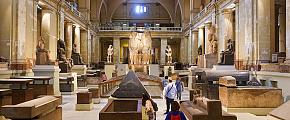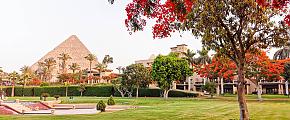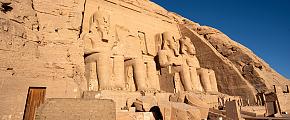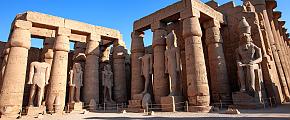Things You Should Know About the Pyramids of Giza
1. What Are the Pyramids of Giza?
The Pyramids of Giza are located on the west bank of the Nile River on the Giza plateau, 22 km south of Cairo, in northern Egypt.
There are three major pyramids on the site: the pyramid for Khufu, also known as the Great Pyramid, the pyramid for King Khafre, and the pyramid for King Menkaure. There is also a Great Sphinx functioning as a guardian to this royal place.
The pyramids, as the final resting place for kings and pharaohs of ancient Egypt, function as pathways for the kings' souls to get close to the gods. Historians argued that pyramids symbolize sunlight spreading to the earth, or they could also indicate the ancient mound of creation.
As one of the Seven Wonders of the World, the pyramids of Giza were included in the UNESCO World Heritage Site in 1979.
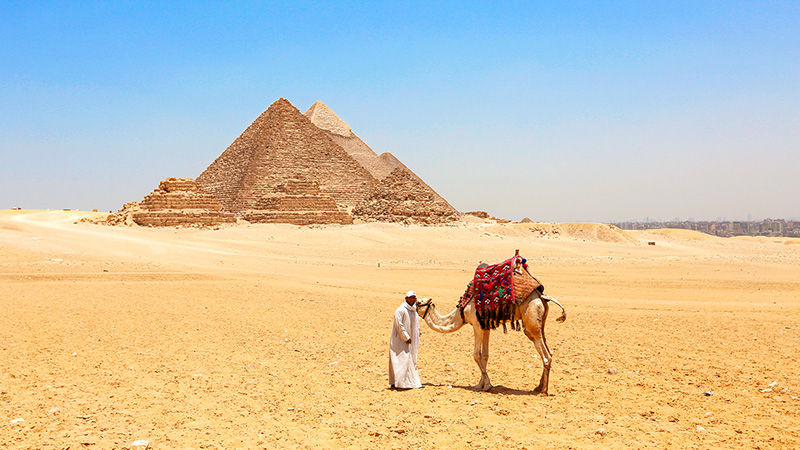 Pyramids of Giza
Pyramids of Giza
2. A Brief History of the Pyramids of Giza
The Pyramids of Giza were constructed during c. 2575-c.2465 BC, by King Khufu, King Khafre, and King Menkaure, the second, fourth, and fifth king of the 4th dynasty.
King Khufu's tomb, known as the Great Pyramid today, is the largest in the pyramids complex, as well as the tallest man-made structure in the globe. According to historians, shortly after King Khufu came to power (2589-2566 BC), he began to build his grand tomb, and it took him almost 20 years to complete this splendid work.
The Pyramid of Khafre is the second-oldest and the second-tallest of the Pyramids of Giza. Khafre was Khufu's son. He was enthroned after King Redjedef, who was likely his older brother and the successor of Khufu. Khafre reigned for less than 3 decades, from approximately 2558 to 2532 BC.
The Pyramid of Menkaure is the smallest pyramid in the pyramid complex. Menkaure was Khafre's son. Historians assumed that he might succeed his father and reign for 18 or 28 years. Menkaure's pyramid remained unfinished when the king deceased, but Shepseskaf, his successor, had the grand tomb finished.
The Great Sphinx is a colossal figure of a recumbent sphinx near the Pyramid of Khafre. Its history may be traced to the reign of King Khafre, who was said to have depicted the sphinx with his own face. The Great Sphinx is also known as one of the landmarks of Egypt, as well as the best symbol of sphinx art.
The pyramids in Giza were ransacked long before their first excavation. Looting was a common practice in many tombs due to the large number of treasures buried there or out of resentment towards the owners of them. Although the pyramids are empty, they remain mysterious and fascinating to Egyptologists, archaeologists, and tourists all over the world.
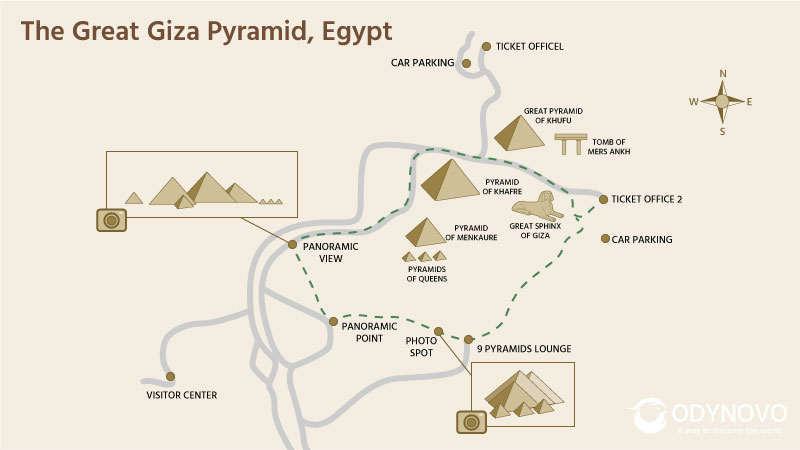 Great Pyramid of Giza Map
Great Pyramid of Giza Map
3. The Layout and Highlights of the Pyramids of Giza
In the Pyramids of Giza, the Great Pyramid of Khufu is in the northernmost. The sides of it rise at an angle of 51°52′, orienting to the four cardinal points of the compass. The Pyramid of Khafre is in the middle, and the Pyramid of Menkaure is in the southernmost. The Great Sphinx is in the southeast, next to the Pyramid of Khafre, safeguarding the pyramids complex.
The Great Pyramid is now 138 meters high, 9 meters lower than its original height because they have been plundered and almost entirely stripped of its outer casings of white limestone. The length of each side at the base is about 230 meters on average. It weighed about 5.75 million tons and was made up of more than two million blocks of stones.
The Pyramid of Khafre measured 216 meters on each side and was originally 143 meters high. The outer casing of the pyramid was originally made of limestone, but now only the topmost part remained.
The Pyramid of Menkaure was originally 66 meters high. Each side of it measures 109 meters.
There is a funerary temple near each pyramid connecting to a valley temple on the edge of the Nile plain via a sloping causeway. Subsidiary pyramids nearby are for other members of the royal family.
The Great Sphinx, carved out of limestone, is approximately 73 meters long and 20 meters high, lying next to Khafre's funeral road. Architectural data revealed that the Sphinx was an integral part of the Khafre Pyramid Complex. Looking at the Sphinx in the face, one can see its nose was gone. One theory is that Napoleon Bonaparte had the Sphinx's nose shot off when he conquered the territory in 1797. According to Egyptologists, however, the damage was done by a saint named Muhammad Saim al-Dahr, who believed it was a false god that did not deserve worship.
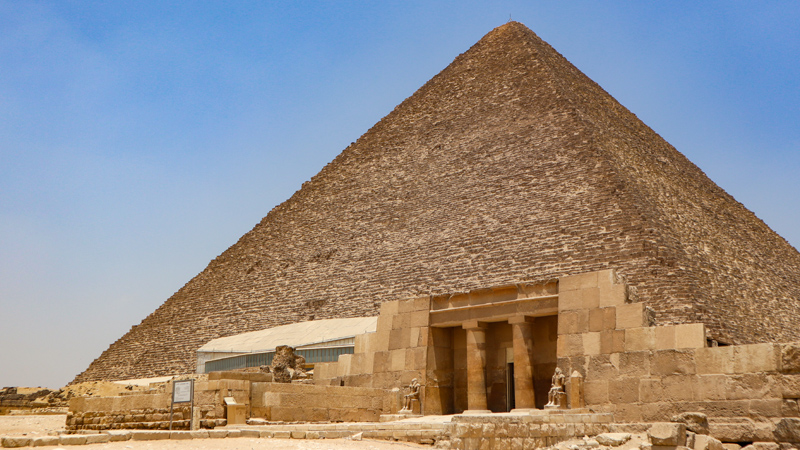 The Great Pyramid of Khufu
The Great Pyramid of Khufu
4. What is Inside the Pyramids of Giza?
Inside the Pyramids of Giza, there are neither treasures nor mummies. Except for the cold rocks and confined space, one will only find a dash of history and mystery within the pyramids.
The entrance to the Great Pyramid is about 18 meters above ground level on the north. Within the pyramid, there's a narrow descending passage leading to an unfinished underground chamber. Above the chamber are five compartments functioning as storage rooms. Below the King's Chamber and the Grand Gallery is the Queen's Chamber, but it probably didn't hold any queens. Queens of Khufu may have been buried in small pyramids nearby.
Inside the Pyramid of Khafre, there is one burial chamber with an area of about 70 m2. Different from other pyramids, this tomb has two entrances and two tunnels to the burial chamber. There is also a mystery hall in the center of the lower corridor, which seems to be a treasury room rather than a burial room, but this assumption has never been confirmed.
Menkaure's pyramid features granite blocks. One interesting fact about this pyramid is that its burial chamber is hidden by an antechamber 6 meters below the pyramid, while the actual burial chamber is still 6 meters lower, connected by another passage.
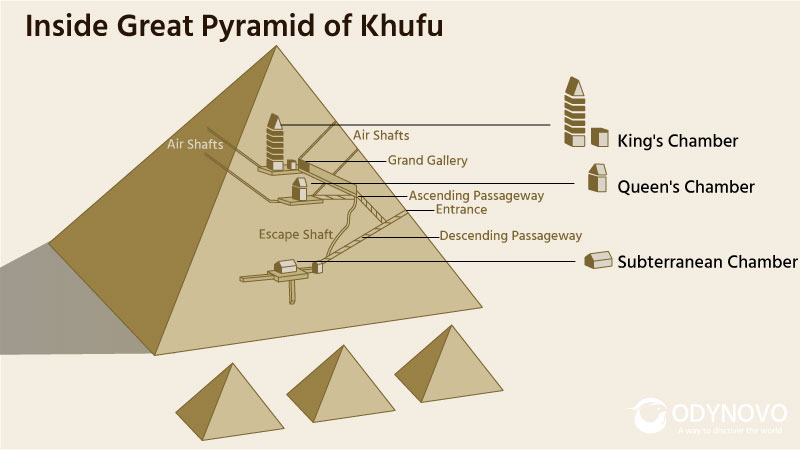 Inside the Giza Pyramid
Inside the Giza Pyramid
5. How did the Egyptians Build the Pyramids?
There were many arguments over how the pyramids were built. The most popular one is that the Egyptians accumulated mounds of stone, earth, and sand to create a ramp, which grew in height and length as the pyramid rose. The ramp was utilized to transport stone blocks by rollers, levers, and sledges. According to Herodotus, an ancient Greek historian, the Great Pyramid took 20 years to construct and demanded a labor force of 100,000 men.
However, in the late 20th century, archeological findings suggested that as few as 20,000 paid workers, rather than enslaved ones, with supporting personnel, have completed this arduous task.
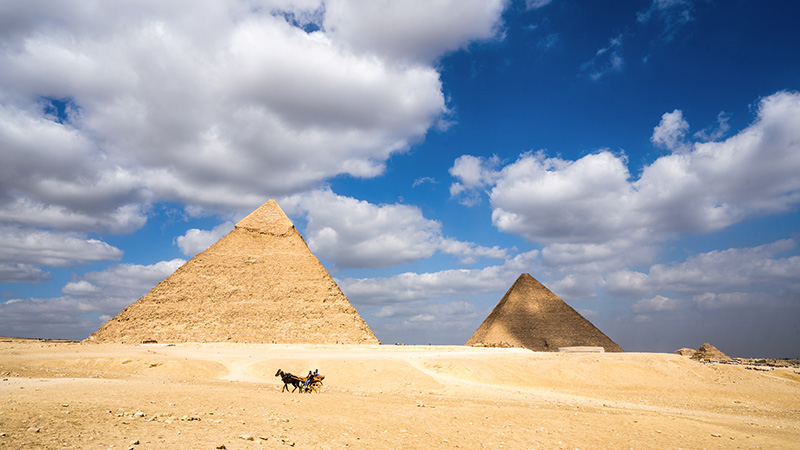 Pyramids of Giza
Pyramids of Giza
6. Who was the First Person to Excavate the Pyramids of Giza?
The first person to excavate the pyramids with modern techniques and scientific analysis is Sir William Mathew Flinders Petrie, a British archaeologist. He invented the "sequence-dating method", which allows assemblages to be arranged in a rough serial order to indicate time in excavations. With this method, he first excavated the pyramids in 1880. Spending half a century of his life in the work of Egypt, the archaeologist was knighted in 1923 for services to British archaeology and Egyptology.
7. Visiting Information
How to Get to the Pyramids of Giza?
The Pyramids of Giza are only 22 km from Cairo. It is recommended to take an Uber or taxi to the place. It will take around 30 minutes.
Opening Hours
Summer (April - September): 8 AM-5 PM
Winter (October - March): 8 AM-4 PM
Last admission: one hour before closing time, i.e., 4 PM in summer and 3 PM in winter.
Best Time for Visit
Winter is a better season for visitors when the weather is relatively mild, with an average temperature of about 22°C (71°F). Try to visit it as early as possible to avoid rushing hours starting from 9 AM.
Entrance Tickets
There are two entrances to the Giza complex- the Great Pyramid entrance and the Sphinx entrance.
The entrance fee for the pyramid complex is 160 EGP (about 7 USD) per person. Extra tickets are required for the inside of the Great Pyramid and the other two pyramids. The former one cost 360 EGP (about 15 USD), and the latter two cost 100 EGP (about 4 USD)
Hire a Guide
Hiring a guide will not only keep you informed of the knowledge behind the pyramids but also free you from the hassles of the peddlers within the complex who will frequently ask you to buy things.
Other Practical Tips
1. Dress appropriately to comply with Arabian culture. Long-sleeved clothes are recommended as it is dusty and sandy in the pyramids complex. Wear comfortable shoes.
2. Bring sunscreen to protect yourself from the desert sun; carry water and snacks.
3. Watch out for thieves and take care of your belongings.
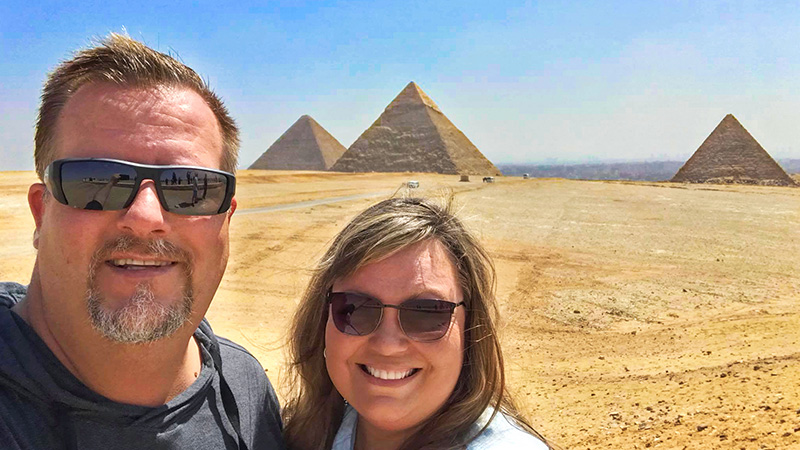 Visit Pyramids of Giza with Sun Protection
Visit Pyramids of Giza with Sun Protection
If you're planning to visit the Pyramids of Giza and explore its unique charm with your own eyes, please don't hesitate to contact us, just simply tell us your interests and needs, and one of our travel experts will create a tailor-made itinerary for you within 24hrs.


